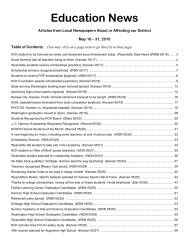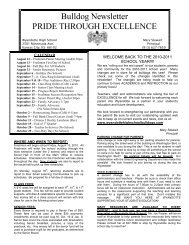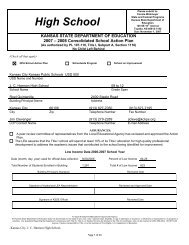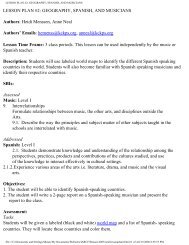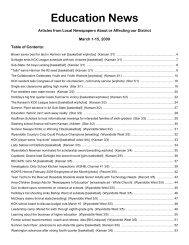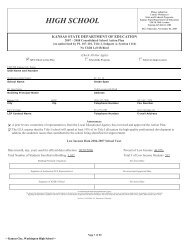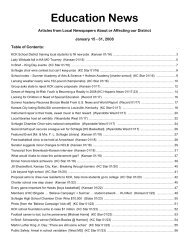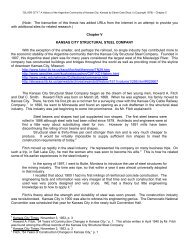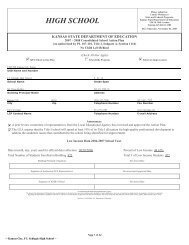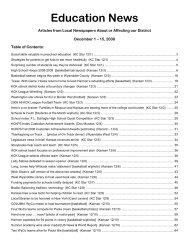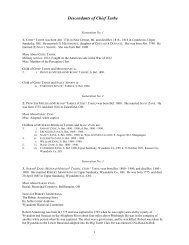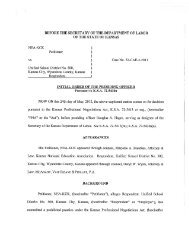Wyandotte - Kansas City, Kansas Public Schools
Wyandotte - Kansas City, Kansas Public Schools
Wyandotte - Kansas City, Kansas Public Schools
Create successful ePaper yourself
Turn your PDF publications into a flip-book with our unique Google optimized e-Paper software.
Part IA. COLLABORATION AND PLANNINGSchool Leadership Team - Suggestion to include: principal, Instruction coach, teachers, SPED teacher, ELL teacher, counselor, parents,and community members.Principal Thompson, Walter JInstructional Coach(es) Stewart, Mary M; Dolezal, Brian J; Andersen, Gary; Kircher, JulieAssistant Principal Barnes, Anna M; Bayer, Robert S; Cooper, Brian T; Kubicki, Kerry ETeachers Johnson, Joetta L; Mcginty, Mary K; Nickum, Paula S; Parbs, Mary K;Robson, Romona; Washburn, Susan E; Wright, Edwin ACounselor(s) Gaitan, Jocelyn L; Hamil, Nancy P; Madrigal, Shelley MSPED Chambers, Traci D; Lake-Asfaw, Cynthia A; Maloney, Edith R; Normandin, Carol A;Robson, RomonaELL Gille, Margaret L; Kepka, Abby; Neidhart, CamilleParents(One Per Line Please)Hollinshed, KimCommunity Jones, Jarius; Allen, ChuckDescribe the process used to develop this plan.ALL STAFF MEMBERS SERVE ON A SCHOOL IMPROVEMENT COMMITTEE IN THE AREA OF MATH OR READING.INADDITION, EACH SMALL LEARNING COMMUNITY FOCUS ON THE INTERVENTIONS DURING THEIR SLC TEACHINGAND LEARNING TIME.COMMITTEES AND SLCS MET REGULAR TO IDENTIFY NECESSARY INTERVENTIONS.CONTENTSTUDY GROUPS ALSO SUBMITTED THEIR INPUT.AN OUTSIDE NORTH CENTRAL TEAM ALSO REVIEWED AND MADERECOMMENDATIONS DURING THE PLANS DEVELOPMENT.Discuss the annual evaluation process for all measurable objectives.All staff, within their small learning community, review formtive and summative assessment data on an ongoing basis. Each May andAugust extensive focus is on reviewing student performance indicators and idnetifying necessary interventions.-- <strong>Kansas</strong> <strong>City</strong>, <strong>Wyandotte</strong> High School --Page 3 of 42
IB. DATA ANALYSISREADINGCompare how the different subgroups and grades scored on the assessment.All of our subgroups went down from last year.As a whole our school dropped from 47% to 31%African American Students dropped from 50% to 34%Hispanic Students dropped from 39% to 27%Free and Reduced Lunch students dropped from 44% to 29%Which subgroups showed the most overall improvement?No subgroups showed improvement.Which subgroups showed the least improvement?All of our Subgroups dropped considerably. African Americans took the largest drop going from 50% to 34%. A 17% drop.What indicators need more time to master? by grade levelFigurative LanguageStructural AnalysisThese were our two lowest areas of performance.What will you do differently?We are focusing on vocabulary strategies in the classroom as well as creating formative assessments called benchmarks in our 9-11th grade curriculum. These are standards based. we will also be testing students two times this year if they are 11th graders inorder to give students more than one opporutnity to pass. We will assess each Sophomore one time.We are also continuing our focus on comprehension.What indicators show where students were the most successful? by grade levelWe scored the highest in Text Features and in Topic Main idea. 68%Second was summarization which was 64%Summary of local assessmentsStudent Groups Percent Proficient 2006-2007Grade 9 21.8Grade 10 15.0Grade 11 23.4Grade 12 23.1MATHCompare how the different subgroups and grades scored on the assessment.Improvement was seen in all subgroups.Which subgroups showed the most overall improvement?All subgroups showed improvement. The most overall improvement was seen with the Hispanic populationWhich subgroups showed the least improvement?Page 4 of 42-- <strong>Kansas</strong> <strong>City</strong>, <strong>Wyandotte</strong> High School --
All subgroups showed improvement. The least improvement was seen with the African-American population. There was a 6.5%improvement over last year. This subgroup went from the highest performing subgroup to the lowest performing subgroup.What indicators need more time to master? by grade levelThe indicators that students perform the lowest on are Formula Applicatons and Transformational Geometry.What will you do differently?**More emphasis in math classes.**More study of different ways to teach the concepts.**More targeted diagnosis with formative data.**Integration with science in emphasizing the content.**Focus on vocabulary to build conceptual understanding.What indicators show where students were the most successful? by grade levelThe indicators that students perform the highest on are Line of Best Fit and Changing an Equation to Slope-Intercept Form.Summary of local assessmentsOnly 13.5% of all students reached proficiency on their local assessment. Large disparity exists among subgroups.-- <strong>Kansas</strong> <strong>City</strong>, <strong>Wyandotte</strong> High School --Page 5 of 42
Disaggregated Data Graphs depicting 2007 <strong>Kansas</strong> Reading and Math Assessments-- <strong>Kansas</strong> <strong>City</strong>, <strong>Wyandotte</strong> High School --Page 6 of 42
-- <strong>Kansas</strong> <strong>City</strong>, <strong>Wyandotte</strong> High School --Page 7 of 42
<strong>Wyandotte</strong> High SchoolPercent of Students At or Above Proficiencyon <strong>Kansas</strong> Reading AssessmentNew KS assessmentimplemented at this 100.0time.90.02002 2003 2004 2005 2006 2007AYP Goal 44.0 44.0 51.0 58.0 58.0 65.0F&R 15.8 31.5 26.7 37.1 44.3 29.4133 175 142 178 160 119Paid 8.7 22.1 28.8 35.3 60.0 40.746 59 45 48 43 27ELL 77.3 80.0 75.8 23.322 20 29 30Disabled 0.0 26.7 43.4 56.0 33.320 30 23 25 25Migrant 42.814White 22.2 35.2 10.0 50.1 52.9 35.318 17 10 18 20 17Black 10.3 19.4 22.7 26.3 50.9 34.1116 155 123 122 108 79Asian 20.010Hispanic 20.6 53.8 48.8 49.3 39.0 27.734 52 43 75 64 47Male 12.6 27.2 28.1 34.8 48.9 38.387 114 89 115 109 60Female 15.2 30.8 26.5 38.7 45.4 26.792 120 98 111 113 86School Total 14.0 29.1 27.3 36.8 47.1 31.5Number Tested 179 234 187 226 195 146Student Gro oupsSmall font numbers for each group indicate group size.Results are not reported for student groups smaller than 10 members.80.070.060.050.040.030.020.010.00.02002 2003 2004 2005 2006 2007AYP Goal F&R PaidELL Disabled MigrantWhite Black AsianHispanic Male FemaleSchool TotalPage 8 of 42
-- <strong>Kansas</strong> <strong>City</strong>, <strong>Wyandotte</strong> High School --Page 9 of 42
-- <strong>Kansas</strong> <strong>City</strong>, <strong>Wyandotte</strong> High School --Page 10 of 42
<strong>Wyandotte</strong> High SchoolPercent of Students At or Above Proficiencyon <strong>Kansas</strong> Math AssessmentNew KS assessmentimplemented at this 100.0time.90.02002 2003 2004 2005 2006 2007AYP Goal 29.1 29.1 38.0 46.8 46.8 55.7F&R 2.2 4.4 7.7 10.4 29.6 40.0182 205 208 193 155 140Paid 1.7 3.1 5.9 9.5 26.8 38.560 64 51 42 45 26ELL 0.0 4.4 2.9 14.3 10.7 20.036 45 34 42 37 20Disabled 0.0 8.6 23.4 20.0 40.036 35 30 30 30Migrant 0.0 8.311 12White 4.8 11.1 17.4 16.7 45.0 43.821 18 23 18 22 16Black 1.2 3.1 6.1 5.0 30.4 37.0161 159 148 120 105 89Asian 10.0 20.010 10Hispanic 4.1 3.8 5.3 15.2 21.2 41.149 80 75 86 66 56Male 1.6 4.7 6.9 13.3 36.2 46.6123 127 146 120 108 73Female 2.5 3.5 8.0 7.0 22.8 34.4118 142 113 115 125 93School Total 2.1 4.1 7.3 10.3 29.0 39.8Number Tested 242 269 259 235 196 166Student Gro oupsSmall font numbers for each group indicate group size.Results are not reported for student groups smaller than 10 members.80.070.060.050.040.030.020.010.00.02002 2003 2004 2005 2006 2007AYP Goal F&R PaidELL Disabled MigrantWhite Black AsianHispanic Male FemaleSchool TotalPage 11 of 42
<strong>Kansas</strong> <strong>City</strong>, <strong>Kansas</strong> School Improvement PlanSchool <strong>Wyandotte</strong> High SchoolReadingII. Data Disaggregation by DemographicsGroups% at AcademicWarning% at ApproachesStandardState Assessment% at MeetsStandard% at ExceedsStandard% at ExemplaryLocal Assessment% at Proficient oraboveAll Students 32.87 35.61 23.28 7.53 .68 20.5Caucasion 17.64 47.05 23.52 11.76 0.00 26.7African American 31.64 34.17 25.31 7.59 1.26 20.2Hispanic 38.29 34.04 21.27 6.38 0.00 18.9AsianAmerican IndianMale 35.00 26.66 23.33 13.33 1.66 21.8Female 31.39 41.86 23.25 3.48 0.00 19.5Free/Reduced 35.29 35.29 21.00 7.56 0.84 21.4PaidSPED 42.85 52.38 4.76 0.00 0.00ESL 88.23 11.76 0.00 0.00 0.00 4.1Migrant 32.69 21.15 32.69 11.53 1.92 33.3Data Disaggregation by Grade Level (all which apply to this building)Grade910% at AcademicWarning% at ApproachesStandardState Assessment% at MeetsStandard% at ExceedsStandard% at ExemplaryLocal Assessment% at Proficient orabove11 32.87 35.61 23.28 7.53 .68 20.512-- <strong>Kansas</strong> <strong>City</strong>, <strong>Wyandotte</strong> High School --Page 12 of 42
II. Data Disaggregation by Demographics -- continued --Based on the site data, identify your building Reading GoalA minimum of 72.0% of the whole population and each of the subgroups will perform at least at the proficiency level or show gainsto make safe harbor or the confidence levels on the <strong>Kansas</strong> State Reading Assessment.A minimum of 72.0% of all Free and Reduced Lunch students will perform at least at the proficiency level or show gains to makesafe harbor or the confidence levels on the <strong>Kansas</strong> State Reading Assessment.A minimum of 72.0% of all African American students will perform at least at the proficiency level or show gains to make safeharbor or the confidence levels on the <strong>Kansas</strong> State Reading Assessment.A minimum of 72.0% of all Hispanic students will perform at least at the proficiency level or show gains to make safe harbor or theconfidence levels on the <strong>Kansas</strong> State Reading Assessment.Identify the relevant State Standards and Indicators the site will focus on based on the building Reading GoalStructural AnalysisVocabulary in ContextAuthor's Purpose-- <strong>Kansas</strong> <strong>City</strong>, <strong>Wyandotte</strong> High School --Page 13 of 42
Reading Targets based on the <strong>Kansas</strong> <strong>City</strong>, <strong>Kansas</strong> Literacy Model (based on data analysis check no more than two targetedstrategies)A. Phonological/Phonemic AwarenessB. Phonics InstructionC. VocabularyWe will improve Vocabulary skills for the following tiers (check all that apply)gfedcb All Studentsgfedc Some Studentsgfedc Few Studentsgfedc Gendergfedc African Americansgfedc SESgfedc Hispanicsgfedc ELLgfedc Whitesgfedc SPEDgfedc Asian Pacific Islandersgfedc American Indiansgfedc Mulit-Ethnic and Undeclaredgfedc K gfedc 1 gfedc 2 gfedc 3 gfedc 4 gfedc 5 gfedc 6 gfedc 7 gfedc 8 gfedc 9 gfedc 10 gfedc 11 gfedc 12The student will improve Vocabulary skills through scaffolded instruction using:Strategy Research Resources Person ResponsibleWord Study Gillet, J.W., & Temple, C..(1982). Understanding Reading Problems:Assessment and Instruction.. Boston:Little, Brown,CooperAnna BarnesWyandote teachers are focusing on word walls.There is currently a number of staff members (18)that are involved in a Literacy First initiative trainingthem on specific vocabulary and comprehensionstrategies. These people in turn are training theirSLCs over the vocabulary strategies. There is anemphasis on structural analysisAllen, J..(1999). Words, Words,Words, StenhousePublishing.Beers, K..(2003). When Kids Can’tRead: What Teachers CanDo. Portsmouth, NH,Heinemann.Robert Marzano(2005) Buidlind AcademicVocabualry, ASCDDoug Buehl(2005)Classrooms structures forInteractive Learning. ASCDWalter ThompsonBrian DolezalKerryKubickiRobert BayerBrian-- <strong>Kansas</strong> <strong>City</strong>, <strong>Wyandotte</strong> High School --Page 14 of 42
D. FluencyE. ComprehensionWe will improve Comprehension skills for the following tiers (check all that apply)gfedcb All Studentsgfedc Some Studentsgfedc Few Studentsgfedc Gendergfedc African Americansgfedc SESgfedc Hispanicsgfedc ELLgfedc Whitesgfedc SPEDgfedc Asian Pacific Islandersgfedc American Indiansgfedc Mulit-Ethnic and Undeclaredgfedc K gfedc 1 gfedc 2 gfedc 3 gfedc 4 gfedc 5 gfedc 6 gfedc 7 gfedc 8 gfedc 9 gfedc 10 gfedc 11 gfedc 12The student will improve Comprehension skills through scaffolded instruction using:Strategy Research Resources Person ResponsibleAccessing PriorKnowledgeHerber, H..(1978). Teaching reading in content areas(2nd ed) Englewood Cliffs, NJ: Prentice-Hall.Teachers are recieving training in Literacy First onVarious ways to improve Comprehension. One ofthose components is the Anatomy of a Lesson.Built into this Anatomy is explicit ways to improveAccessing Background Knowledge. Teachers inturn are training their SLCs.Beers, K..(2003). When Kids Can’tRead: What Teachers CanDo. Portsmouth, NH,Heinemann.Buehl, D..(2001). ClassroomStrategies for InteractiveLearning.Newark, DE:International ReadingAssociation.Marzano, R..(2004). BuildingBackground Knowledge forAcademic Achievement.Alexandria, VA. ASCD.Robb, L..(2003). Teaching Readingin Social Studies, Science,and Math. New York:Scholastic\.Zwiers, J.(2004). Building ReadingComprehension Habits inGrades 6-12: A Toolkit ofClassroom Activities.Newark, DE, InternationalReading Association..Walter Thompson, Robert Bayer,Brian Cooper, Kerri Kubicki, BrianDoleza-- <strong>Kansas</strong> <strong>City</strong>, <strong>Wyandotte</strong> High School --Page 15 of 42
F. MotivationG. OtherSCIENTIFICALLY BASED RESEARCH for ReadingDescribe how the selected strategies are supported by scientifically based reading research to address your targeted student needs.The selected strategies represent current scientific based research in the field of literacy. They reflect the dimensions of reading as outlined bythe National Reading Panel report. These strategies are effective with all students as reported by the National Reading Panel. Therefore, theselected strategies address the targeted student needs.-- <strong>Kansas</strong> <strong>City</strong>, <strong>Wyandotte</strong> High School --Page 16 of 42
Formative Assessments for ReadingFor each target selected, identify the formative assessments that will be used to monitor effectiveness and success of strategy.TargetFormative AssessmentA.Phonological/PhonemicAwarenessB. PhonicsC. Vocabulary Benchmark Assessments built into the curriculum (9-11th grade) NWEA MAP assessment for 9th and 10thgraders Use of the CETE website for formative assesmentsD. FluencyE. Comprehension Benchmark Assessments built into the curriculum. (9-11th grade) NWEA MAP assessment for 9th and 10thgraders. Use of the CETE website for formative assessments.F. MotivationG. OtherResults-Based Staff Development Plan For Reading(Complete for each target selected)Knowledge LevelActivities (for example:workshops, study groups,classes, professionalreading)A.Phonological/PhonemicAwarenessB. PhonicsLiteracy FirstC. Vocabularyconsultants. Monthlytrainings. Vocabularyis a part of the NCAgoal and all teachersare expected to haveword walls in theirclassrooms. SLCmembers involved inLiteracy First aretraining other staffmembers with thestrategies.D. FluencyLiteracy FirstE. Comprehensionconsultants. Monthlytrainings. SLCmembers involved inLiteracy First aretraining other staffmembers with thestrategies using DougBuehl.F. MotivationG. OtherStaff DevelopmentResources NeededModeling and/orDemonstration Activities(for example: jobembeddedsample lessons,observations)Practice with FeedbackActivities (for example,job-embedded walk-thru,peer observations andconferences)Follow-up Activities(for example, jobembeddedstudyingstudent work, dataanalysis)Dates Dates Dates DatesOn GoingOn GoingPeer coaching isimplemented usingsubs to coverclassrooms so teacherscan observe otherteachersPeer coaching isimplemented usingsubs to coverclassrooms so teacherscan observe otherteachersOn GoingOn GoingWalk throughs withLiteracy FirstConsultant as well asadministrative walkthroughs.Walk throughs withLiteracy FirstConsultant as well asadministrative walkthroughs.On GoingOn GoingThere will be followup trainingsthroughout the schoolyear.There will be followup trainingsthroughout the schoolyear.OnGoingOnGoing-- <strong>Kansas</strong> <strong>City</strong>, <strong>Wyandotte</strong> High School --Page 17 of 42
<strong>Kansas</strong> <strong>City</strong>, <strong>Kansas</strong> School Improvement PlanSchool <strong>Wyandotte</strong> High SchoolMathematicsIII. Data Disaggregation by DemographicsGroups% at AcademicWarning% at ApproachesStandardState Assessment% at MeetsStandard% at ExceedsStandard% at ExemplaryLocal Assessment% at Proficient oraboveAll Students 36.14 24.09 26.50 11.44 1.80 13.5Caucasion 18.75 37.50 25.00 12.50 6.25 22.5African American 38.20 24.71 24.71 10.11 2.24 9.2Hispanic 37.50 21.42 30.35 10.71 0.00 16.1AsianAmerican IndianMale 30.13 23.28 28.76 13.69 4.10 15.4Female 40.86 24.73 24.73 9.67 0.00 11.5Free/Reduced 37.85 22.14 25.71 12.85 1.42 13.5Paid 23.80 38.09 28.57 4.76 4.76 13.9SPED 33.33 62.50 4.16 0.00 0.00ESL 60.00 20.00 20.00 0.00 0.00 4.7Migrant 11.76 47.05 29.41 5.88 5.88Data Disaggregation by Grade Level (all which apply to this building)Grade910% at AcademicWarning% at ApproachesStandardState Assessment% at MeetsStandard% at ExceedsStandard% at ExemplaryLocal Assessment% at Proficient orabove11 36.14 24.09 26.50 11.44 1.80 13.512-- <strong>Kansas</strong> <strong>City</strong>, <strong>Wyandotte</strong> High School --Page 18 of 42
III. Data Disaggregation by Demographics -- continued --Based on the site data, identify your building Mathematics GoalA minimum of 64.6% of the whole population and each of the subgroups will perform at least at the proficiency level or show gains tomake safe harbor or the confidence levels on the <strong>Kansas</strong> State Mathematics Assessment.Identify the relevant State Standards and Indicators the site will focus on based on the building MathematicsGoalFormula application-- <strong>Kansas</strong> <strong>City</strong>, <strong>Wyandotte</strong> High School --Page 19 of 42
Mathematics Targets based on the <strong>Kansas</strong> <strong>City</strong>, <strong>Kansas</strong> Mathematics Model(based on data analysis check no more than two targeted strategies)A. Conceptual Understanding; Computational and Procedural Fluency; Strategic Competence (Problem Solving); AdaptiveReasoning; Positive, Production DispositionWe will improve Conceptual Understanding; Computational and Procedural Fluency; Strategic Competence (Problem Solving);Adaptive Reasoning; Positive, Production Disposition skills for the following tiers (check all that apply)gfedcb All Studentsgfedc Some Studentsgfedc Few Studentsgfedc Gendergfedc African Americansgfedc SESgfedc Hispanicsgfedc ELLgfedc Whitesgfedc SPEDgfedc Asian Pacific Islandersgfedc American Indiansgfedc Mulit-Ethnic and Undeclaredgfedc K gfedc 1 gfedc 2 gfedc 3 gfedc 4 gfedc 5 gfedc 6 gfedc 7 gfedc 8 gfedc 9 gfedc 10 gfedc 11 gfedc 12The student will improve Conceptual Understanding; Computational and Procedural Fluency; Strategic Competence (ProblemSolving); Adaptive Reasoning; Positive, Production Disposition skills through scaffolded instruction using:Strategy Research Resources Person ResponsibleVocabularyAcquisitionBaker, S.K., Simons, D.C. & Kameenui, E.J..(1995). Vocabulary acquisition: Synthesisof the research. Eugene, OR: Universityof Oregon, . Technical Report, No. 13),Kilpatrick, J., Swafford, J., & Findell, B. (Eds.).(2001). Adding it up: Helping childrenlearn mathematics. Washington, DC:Mathematics Learning Study Committee,Center for Education, Division ofBehavioral and Social Sciences andEducation, National Academy Press..Monroe, E. E. .(1998). Using graphic organizers to teachvocabulary: Does available researchinform mathematics instruction? .Usiskin, Z..(1996). Communication in mathematics,K – 12 and beyond (1996 Yearbook).Reston, VA: National Council ofTeachers of Mathematics..Barton, M.L., & Heidema, C..(2002). Teaching reading inmathematics, (2nd ed.).Aurora, CO: Mid-continentResearch for Education andLearning..Murray, M..(2004). Teachingmathematics vocabulary incontext. Portsmouth, NH:Heinemann..Readence, J.E., Bean, T.W., &Baldwin, R.S..(2001). Content arealiteracy: An integratedapproach, (7th ed.).Dubuque, IA: KendallHunt..Mary StewartEddie WrightSusan WashburnLesley HornbergerCecil ChristwellKathy ParbsWilliam WellsSarah MihalevichTerri JohnsonVicki Eddleman-- <strong>Kansas</strong> <strong>City</strong>, <strong>Wyandotte</strong> High School --Page 20 of 42
G. OtherSCIENTIFICALLY BASED RESEARCH for MathematicsDescribe how the selected strategies are supported by scientifically based research to address your targeted student needs.The selected strategies represent current scientific based research in the field of mathematics. They reflect the fivestrands of mathematical proficiency as outlined by the National Research Council. These strategies are effective withall students as reported by the National Research Council. Therefore, the selected strategies address the targeted studentneeds.-- <strong>Kansas</strong> <strong>City</strong>, <strong>Wyandotte</strong> High School --Page 21 of 42
Describe what your school will implement to support the identified teaching and learningneeds of students in each content area to bring about increased academicachievement.Multi-Tiered System of Supports (MTSS)RtIThird TierIntensive SupportSecond TierDifferentiated – Flexible GroupFirst TierHigh Quality – Whole Group5 – 10%20 – 30%100%RESEARCHBureau of Exceptional Education and Student Services: Florida Department ofEducation. (2006). The response to intervention (RtI) model (Technicalassistance paper No. 12740). Tallahassee, FL.Christ, T. J., Burns, M. K., & Ysseldyke, J. E. (2005). Conceptual confusion withinresponse-to-intervention vernacular: Clarifying meaningful differences. NASPCommuniqué, 34 (3), 1-8.Denton, C. A. (Ed.). (2006, Winter). Responsiveness to Intervention as an Indication ofLearning Disability [Theme Issue]. Perspectives. 32(1).Fletcher, J. M., Lyon, G.R., Fuchs, L..S., & Barnes, M.A. (2007). Learning disabilities:From identification to intervention. New York: Guilford Press.Jimerson, Shane R.; Burns, Matthew K.; VanDerHeyden, Amanda (Eds.) (2007).Handbook of response to intervention: The science and practice of assessmentand intervention. New York: Springer.National Association of State Directors of Special Education (2005). Response tointervention: Policy considerations and implementationWalpole, Sharon; McKenna, Michael C., Differentiated Reading Instruction Strategiesfor Primary Grades, 2007. The Guilford Press, NY-- <strong>Kansas</strong> <strong>City</strong>, <strong>Wyandotte</strong> High School --Page 23 of 42
Tier 1Whole class instructionStrategies based on: Phonological/Phonemic Awareness (Elementary only)Phonics Instruction (Elementary only)See sectionVocabularyon ReadingFluencyStrategiesComprehensionMotivation (Elementary only)Strategies based on: Conceptual Understanding; Computational and ProceduralSee sectionon MathStrategiesFluency; Strategic Competence (Problem Solving);Adaptive Reasoning; Positive, Production DispositionTier 2More Time:Tutoring: After School, Saturday School, Before School, During LunchBenchmark Recovery – Additional time for students struggling inpassing their benchmarksDouble DipPull Outs – from student elective periods and teacher planning timeSystematic Instruction in Phoneme Awareness, Phonics, and Sight words (SIPPS)Read 180Differentiated InstructionFlexible groupingReading & Math Achievers – students who are at proficient plus percentage of studentsapproaching standardsOutside consultants to set goals and expectations with Leadership team – Reading &Math. Consultants recommend specific strategies to improve effectiveness ofinstructionAdvocates in constant touch with parents on student progressTier 3Individualized InstructionSame tutoring opportunities as Tier 2Differentiated InstructionIn addition to Tier 1Assessment basedIntensive all day tutoring to selected students who need additional practice (monthly)Many of the items listed in Tier 2 are also used as Tier 3SPED services – for students who qualify-- <strong>Kansas</strong> <strong>City</strong>, <strong>Wyandotte</strong> High School --Page 24 of 42
V. PROFESSIONAL DEVELOPMENT FOR SCIENTIFICALLY BASED RESEARCHSTRATEGIES WITH TIME LINEDescribe the high quality and ongoing professional development that will support the schoolwide reform strategiesJuly 30th: Representatives from each Small Learning Community trained in Literacy First Reading Strategies usingresearch from Doug Buehl and Robert Marzano. Each SLC is training their SLCs on these strategies.Each Monday afternoon, English teachers are meeting around implementation of benchmarks in the the new LanguageArts curriculum. Benchmarks are specific learning goals set in each Language Arts grade level that students must knowbefore receiving a grade.Each Tuesday afternoon Reading Enhancement teachers are meeting to discuss data and the effectiveness of their readingstrategies.Each Monday afternoon, Math teachers are meeting around implementation of benchmarks in the Math curriculum.Benchmarks are specific learning targets that identify the minimum content knowledge students must know beforereceiving a grade.Describe how the plan is integrated with the school’s results-based staff development plan, including a timelineThe goal for <strong>Wyandotte</strong> High School is 68% of our students being at proficient on the <strong>Kansas</strong> Reading Assessment. Thegoal for math is 52%.July Literacy First training 18 people representing the each SLC.August - Math Team retreat to identify goals and priorities.September Implementation of benchmark system. Monday study team for Language Arts and Math. Tuesday study teamfor Reading Enhancement. Look at curriculum development, student supports, and data. Focus Content Wednesday workaround the implementation.October: Support systems in place for students to make up benchmarks or recieve tutoring. Also have a swing teacher inplace to assist students during the school day. Continue with Literacy First. Analyze September Math Scrimmage.November: Test each Junior on KRA. Examine results and begin work towards addressing where students are notproficient utilizing the swing teacher. Sophomores who are in an English Class first semester will take KRA and we willutilize results for Junior Year. Begin training SLCs in Literacy First strategies. Focus on Achievers and students nottaking ownership of learning.Analyze October Math Scrimmage.December: Continue training in Literacy First with SLCs with an expectation of implementation of trained strategies.Continue to analyze results of <strong>Kansas</strong> Reading Assessement. Develop action plans for students not proficient. Continuewith Monday and Tuesday Study teams. Continue focus on students who are not taking ownership of learning as well asthose students who are achievers. Analyze semester math scrimmage data.January: Begin Second Semester of implementation of benchmarks. Revise current system to hold higher accountablityfor students. Continue to utilize results and implement action plan for students not proficient in certain benchmarks.Continue with study teams on Monday and Tuesday. Literacy First training continues in SLC as well as training SLCrepresentatives.February: Continue with second semester of implementation of the above.March: Give second round of assessments with student who were not proficient first semester of their Junior Year. TestSophomores in Language Arts Second Semester. Begin math testing.April: Analzye results and look at individual benchmarks. Revise curriculum and staff development to fit the needs of ourstudents. Describe how professional development resources will be sufficient to effectively carry out the schoolwide reformPage 25 of 42-- <strong>Kansas</strong> <strong>City</strong>, <strong>Wyandotte</strong> High School --
strategiesDescribe the research behind the scientifically based strategies used by the staff.The work of Robert Marzano is well known. Students who recieve direct vocabulary instruction as a part of theircurriculum score better on standardized comprehension tests than student who recieve no vocabulary instruction. Astudent's vocabulary has a direct impact on their reading comprehension and achievement. We are also focusing on DougBuehl and his work with interactive learning strategies.The leadership team in the district has studied the Mike Schmoker model of professional development and we areimplementing aspects of it in our work. Also the work of Richard DuFour and his research on Professional LearningCommunities.We have also looked at the work of Rick Wormelin and the notion of Differentiated Assessment. We are using that as aframework for our benchmark development.Describe how teachers will use academic assessments to provide information for improved instructional practices forsupporting individual student achievement.Benchmarks have been created within the Language Arts, Math, Science, and Social Studies curriculum.The purpose of these benchmarks is to provide students with explicit learning statements Ownership of learning short frequent assessements to track their own learning.The purpose of these benchmarks for teachers is to: provide ongoing consistent feedback of student progress Give teachers hard data to base instrucitonal decisions. Provide common assessment for dialouge.Describe the school’s teacher-mentoring program. Include written policies and guidelines that specifically address howthe teacher-mentoring program focuses on scientifically based research strategies related to reading* and/ormathematics.*The purpose of the <strong>Kansas</strong> <strong>City</strong>, <strong>Kansas</strong> mentoring program is to provide beginning teachers with asupportive, formative process designed to assist their growth as reflective practitioners. The programis both structured and flexible, and consists of a series of strategies focused on the process ofteaching. Designed for beginning teachers with the assistance of trained mentors, the program isground in a developmental view of learning to teach.The program combines three essential elements for developing and sustaining teacher quality insupport of student learning: a common language for talking about and assessing teaching; clear andconcrete levels of performance for teachers to use in assessing themselves; and structured eventsthrough which beginning teachers can develop or hone their skills.The <strong>Kansas</strong> <strong>City</strong>, <strong>Kansas</strong> mentor program is based on the ASK, Inc. mentoring Program developedby Paula Rutherford. Two books will be used by the rookies. Why Didn’t I Learn this in College?and Instruction for All Students. A third book Mentoring in the 21st Century will be used by thementors, instructional coaches and administrators.The <strong>Kansas</strong> <strong>City</strong> <strong>Kansas</strong> mentoring program is built on five goals:Beginning teachers will work with a mentor to develop or enhance teaching skills. A log sheetis turned in at every meeting specifying the topics and time spent in collaboration. TheCoordinator of Induction makes a minimum visit to the schools (48 in total) twice a semester to-- <strong>Kansas</strong> <strong>City</strong>, <strong>Wyandotte</strong> High School --Page 26 of 42
observe the progress and have individual conversation with the pair to determine progress.Beginning teachers will acquire knowledge necessary to become familiar with the district,school, and community. An orientation to the district is given the firt two duty days (theircontract is extended two days) offering classes areas unique to our district and community. Theguided reading as it is done in primary grades, teaching to diverse students, First Things Firstand how our district does business, computer systems unique to our schools, and BISTdiscipline procedures.Beginning teachers will participate in monthly professional development meetings to enhanceand improve skills effective teaching skills. The beginning teachers are required to attendmeetings each month to reflect and learn teaching techniques helping them to become betterinstructors and caring advocates for their students.Beginning teachers and their mentor will develop and enhance professional and workingrelationships. Our mentors and beginning teachers are asked to spend a minimum of one hourweekly in collaborative conversation. They keep a log of topics and time spent. The log isturned in at each of the beginning teacher after school meetings.Mentors will develop and enhance skills necessary to provide professional and personalassistance for their beginning teacher. Because the beginning teachers have a major part toplay in the selection of his/her mentor, relationships start from the first day of the year. Thementors have provided guidance and direction voluntarily before they were even chosen. Asthe relationship develops and conversations between the two teachers become more focused onclassroom success, the mentors will have opportunity to evaluate their own teaching practices.The mentors have the same program books as the beginning teacher and together they canstudy the area topic for the month and reflect on the results of the new teaching from thebeginning teacher.The program involves several distinct types of structure topics, with activities assigned monthly asaddressed during after school in-services. Attendances at monthly meetings are mandatory.The topics addressed are designed to increase the comfort and teaching skills within the classroom.There are a total of seven topics required for the beginning teacher to explore and add to theirprofessional “tool belt.” The mentor teacher becomes the source of encouragement, reflection, andcoaching for their success by monthly observations in the beginning teacher’s classroom.Basic criteria established for mentor selection meet the standards developed by the State Board ofEducation. Mentors must be licensed with at least three consecutive years teaching with the district.Participation is voluntary.Each topic enables beginning teachers to explore different aspects of their practice and to becomeincreasingly proficient in the components of professional practice. The topics require theparticipation of both beginning teachers and their mentors, thereby encouraging professionalcollaboration and growth for both teachers.The syllabus for the training of mentors and administrators include all of the following components:Developmental stages of the new teacherRoles and responsibilities of the mentorCoaching, observation and feedbackRelationship buildingCollaborationConfidentiality* In order to comply with ESEA, scientifically based research strategies must be derived from the five components of reading from the Center for the Improvement of Early ReadingAchievement (CIERA) and the National Institute for Literacy, drawn from the 2000 report of the National Reading Panel. Scientifically based research strategies for mathematics should reflectthe five strands of mathematics from the National Research Council, Helping Children Learn Mathematics and Adding It Up.-- <strong>Kansas</strong> <strong>City</strong>, <strong>Wyandotte</strong> High School --Page 27 of 42
-- <strong>Kansas</strong> <strong>City</strong>, <strong>Wyandotte</strong> High School --Page 28 of 42
VI. HIGHLY QUALIFIED STAFFHow will the school ensure instruction by highly qualified teachers?Teachers in the district are required to attend district wide training each quarter. Training involves the implementation ofdistrict-mandated programs. For the middle school, the math department focuses on best practices for teaching ConnectedMath and the reading department focuses on best practices for teaching Read 180, Read XL, and High Point. All of theother departments provide support for learning strategies used standards based lessons. All teachers will meet the stateand NCLB definition of Highly Qualified or will have a plan on file at the Professional Development office on how andwhen they will fulfill that requirement. Teachers who are teaching in an unendorsed area will also file a plan with theProfessional Development office on how and when they meet those requirementsOther:Describe strategies used to attract highly qualified teachersThe district initiative to First Things First is a major attraction for attracting highly qualified teachers. Lowering pupil /teacher ratio through Title I allows for smaller class sizes. Continuity of care allows the teacher to develop relationshipsand work with the same students over a period of years. The high, clear, and fair expectations for academics and behaviorset an atmosphere conducive to learning. Enriched and diverse opportunities to learn provide the teacher with methods forindividualizing instruction and meeting the needs of the students. Collective responsibility ensures collaboration amongthe teachers. The small learning community allows time for common planning. Wednesday afternoon staff developmentprovides the time needed to be able to work with other teachers in the same department. Instructional autonomy permitsteachers to be involved with decision-making. Teachers are actively involved with the decisions regarding the masterschedule and other decisions in their small learning community. Another district initiative is the Teaching Fellows. Thisprogram is provided for people in the community with degrees who would like to become certified in teaching. Duringthe completion of the Master’s program, the Fellow receives training and support from the district and is placed in ateaching position. At the end of the program, the Fellow acquires a teaching certificate.Ten percent of Title I funds and a portion of Tittle IIA funds are set aside for teachers who do not meet the HQ definitionto access for tuition and boox expenses. Teachers who do not mee the definition are sent letters and e-mails froim thedistrict office encouraging them to take advantage for these funds.Other:If applicable, describe how the school will ensure all paraprofessionals meet the qualifications of highly qualified.Paraprofessionals hired prior to No Chlid Left Behind must have passed the Para Pro Test by the end of the 2005 schoolyear. Paraprofessionals hired after NCLB must already meet the highly qualified requirements.Other:-- <strong>Kansas</strong> <strong>City</strong>, <strong>Wyandotte</strong> High School --Page 29 of 42
VII. PARENT INVOLVEMENTWhat strategies are you using to promote effective parent involvement?gfedcbgfedcgfedcgfedcgfedcb1. Participating in the Family Advocacy. In this system parents and students are assigned one advocate or contact person forthe years they attend a particular school. This advocate is their primary support system and source of information. Parentsare included in goal setting with the student and teachers through this system. This ensures that all the adults in the child’seducational experience are on the same page.2. Family Math and Literacy Nights. This is another way to get parents involved in their children’s educational growth. Whenparents begin attending these events they become more familiar with the school, which increases a sense of communityamong students, parents, and staff.3. Hiring a parent liaison to coordinate the family events such as Family Night, conferences, Information Fairs, as well asvolunteers and possibly a PTA?PTSA etc. can help promote parent involvement. If it is the main job of a specific personhoused at the school to coordinate these activities they can happen on a regular basis giving parents and students continuitythroughout the school year.4. Encouraging parents to observe in classrooms – read with the students, or assist teachers helps increase parent ownership oftheir children’s education, the school, and become more aware of the daily workings of the school. Additionally behavior ofstudents improves because an additional adult, specifically a student’s parent, has a presence in the classroom.5. When teachers contact parents on a minimum of a monthly basis to share achievements and positive feed back on theirstudents it establishes a good rapport early on so that when negative issues must be addressed a collaborative relationshiphas already been built. This helps to keep all the adults involved in a student’s education on the same page, reducingcommunication barriers. This also helps to increase attendance at school events and family conferencesOther Parent Involvement strategies:Provide a time line with opportunities for parental involvement.<strong>Kansas</strong> <strong>City</strong>, <strong>Kansas</strong> promotes and develops parent involvement through it family advocacy program, which offers a very clear structureand regular timeline.Family Advocacy is a way to build a bridge betweenschool and home so that students, their families, and the school staff can all worktogether as team. With the ultimate goal of improved student performance, Family Advocacy is designed to engage families in theeducation of their children and create a relationship for every student with a school staff member dedicated to that student's success.The Family Advocacy System matches every student, pre K-12, in the district with an adult, his or her Advocate. The Advocate is often,but not limited to, a teacher. The Advocate's role is to monitor the student's academic, social, and emotional development on an ongoingbasis, working in partnership with the family for the student's welfare. they do this in three ways:1. All advocates maintain weekly personal contact with their assigned students throughout the year:-Check in with each of them in a private face-to-face conversation for five minutes a week.-Conduct a weekly 30 minute Family Advocacy session with their assigned students around social and affective issues.2. Maintain monthly contact with the family:-Keep school and home connected with a phone call, note, email, postcard, newsletter, etc. Thisprovides a regular quick update on student progress and develops the home/school relationship.3.Hold at least two conferences per year with the sutdent and family:-Meet with the family, including the student, once a semester for about 30 minutes.-Family conferences include communication between home and school, student goal setting, andplanning for the future.-- <strong>Kansas</strong> <strong>City</strong>, <strong>Wyandotte</strong> High School --Page 30 of 42
District Policy – Parent/Community Involvement1.2.0.0.0 Participation by the <strong>Public</strong>2.0 Parent/Community InvolvementThe Board of Education is committed to building a strong partnership with parents, families andcommunity members to achieve academic success for all children. Although parents and families arediverse in culture, language and needs, they share the District’s commitment to the educational success oftheir children. There are many levels of parent involvement, and schools must provide opportunities forparents, families, and community members that meet their interests and utilize their talents. To this end,the Board will:2.1 Provide parents with education and support in setting high expectations for theirchildren and in creating a supportive environment at home for children to study and learn.2.2 Provide parents, families, and community members with information about schoolprograms, opportunities, and expectations and invite their support of the school in its work.2.3 Establish effective two-way communication with all parents, respecting the diversityand differing needs of families.2.4 Develop strategies and programs to empower parents and family members to participateactively in their child’s education.2.5 Bring together schools, students, parents, families, and communities with resources andprogramming that provide educational enrichment and support for academic achievement.2.6 Recognize parents, families, and community members as resources, leaders, andadvisors on school policy and programs through their membership and participation onSchool Site Councils, advisory committees, and task forces.2.7 Provide opportunities for meaningful volunteer participation and recognition ofcontributions in classrooms and the school.1.2.0.0.0-AParticipation by the <strong>Public</strong>2.0 Parent/Community InvolvementThe Board of Education is committed to and supports the mission of promoting life long learners throughsuccessfully education all students. The Board recognizes that the education of children is a responsibilityshared by parents, families, school staff, and communities.Parent and family involvement requires a two-way communication between home and school. It is anongoing process that will assist parents and families to meet their basic obligations as their child’s firsteducator. Such involvement is accomplished in many ways, from active school participation and presenceto working with children at home.The following goals are outlined to assist in achieving an active parent involvement program.2.1 Parent Compacts or Parent Bill of Rights to be developed and instituted within eachschool.2.2 Parent and family involvement component to be developed and implemented by parentsand school staff as part of each school’s improvement plan.2.3 Ongoing activities provided by the district and each individual school to promote parentinvolvement in their child’s education. Activities may include those examples identified inthe Community, Family and Parent Involvement Handbook-- <strong>Kansas</strong> <strong>City</strong>, <strong>Wyandotte</strong> High School --Page 31 of 42
2.4 Behavior exhibited by district personnel that reflects a genuine interest in and supportfor parent, family, and community involvement.2.5 Timely information provided to parents about programs, opportunities, anddistrict/school/teacher contact information through school/district newsletters, invitations,parent teacher association meetings and/or phone calls.2.6 Evaluations on the effectiveness of parent involvement activities will be donethroughout the year with an annual report reflecting the assets and barriers identified in theprocess.-- <strong>Kansas</strong> <strong>City</strong>, <strong>Wyandotte</strong> High School --Page 32 of 42
VIII. TEACHER INVOLVEMENTDescribe how teachers will be involved in using academic assessments to provide information on and improve individualstudent achievement and the overall instructional program.The implementation of benchmarks in the four currciulum areas is giving teachers real data over how students are performing ontheir taught concepts. Each teacher is keeping track of their own data in their classrooms. Benchmarks are used as measures forlearning with teachers as well as formative assessments. "How do I know that my students learned it? What am I going to do ifthey don't learn it?" These two questions are begin answered through a benchmarked system. Teachers and kids know their dataand truly keep track of learning.Monthly scrimmage tests are given in math. Data is analyzed to inform instruction.We will also be utilizing the assessments results of the <strong>Kansas</strong> Reading Assessment as formative piece giving us areas where wemay need improvement in certain areas of the curriculum as well as our teaching.Teachers will also use assessment results on a continous basis to help inform their instruction.-- <strong>Kansas</strong> <strong>City</strong>, <strong>Wyandotte</strong> High School --Page 33 of 42
IX. POLICIES AND PRACTICESPlease describe any policies that provide opportunities to learn and/ or additional time that the district and school has inplace to help ensure that all students enrolled in the school will meet the state’s proficient level on the <strong>Kansas</strong> statereading and mathematics assessments. (Examples may include: attendance policies, discipline policies,retention/promotion policies.)The grading policy of A, B, C, or I is used in all math and English classes. This sends the message that the minimumexpectations for achieving the standards is the same for all, it is the time needed to complete these expectations that mayvary.Please describe any practices that provide opportunities to learn and/or additional time that the district and school has inplace to help ensure that all students enrolled in the school will meet the state’s proficient level on the <strong>Kansas</strong> statereading and mathematics assessments. (Examples may include: student improvement plans, peer tutoring, SaturdaySchool, summer school, etc.)Systems of Supports for achieving the benchmarks include:**After school tutoring**Lunchtime benchmark cafe**Extended school year and extended semester**During the day tutoring by swing teachers**Peer tutoring**Family Advocacy System**Small learning communities collective responsibility-- <strong>Kansas</strong> <strong>City</strong>, <strong>Wyandotte</strong> High School --Page 34 of 42
X. ASSISTANCE TO STUDENTS IN NEEDDescribe the strategies to address the needs of all children, particularly the needs of low-achieving children and those atriskStudents who are not currently meeting benchmarks in the following disciplines have the following support systems.Language Arts:After School tutoring 2:30 to 4:00 two days a week.Wed. Tutoring from 12:30-3:00In school tutoring from adults if student has permission from teacher.Explain how the school will determine if the needs of low achieving students have been metStudents are measured in various ways.One is if students are keeping up and passing the required benchmark assessments in each grade level.Two is if they make improvements in the local NWEA assessment as Freshman and Sophomores.Describe how students in need of assistance will be identified in a timely manner. Describe how a diagnosis of individualstudent needs will be made; and how such students will be provided additional assistance.Teachers keep track of students progress using formative assessments that are built into the existing curriculum. Ifstudents are falling behind with certain benchmarks then teachers are able to get them assisstance with personal tutoringduring the day as well as after school.-- <strong>Kansas</strong> <strong>City</strong>, <strong>Wyandotte</strong> High School --Page 35 of 42
XI. TRANSITION FROM MIDDLE SCHOOL TO HIGH SCHOOL.Decribe the strategies used for assisting students transitioning from middle school to high school.1) Counselors and high school student who represent their thematic community come to visit the middle school student at an assembly.The high school students provide an overview and benefits of belonging to their community. Eighth grade students have a time to askquestions before they begin the enrollment process2) The Family Advocacy System is a district-wide program. When students enter high school, they have a teacher that is assigned astheir advocate for the tme they are in high school.3) The middle school and high school math teachers meet over a period of several months reviewing standards and aligning the mathcurriculum so that there would be continuity of instruction from the middle school to high school. The literacy instructional coaches atthe middle and high school levels also met to create alignment of instruction. Currently, at the district level, two of the middle schoolinstructional coaches are working with high school literacy teachers so that continuity of instruction is occurring in literacy.Other:**The small learning community structure supports the transitioning 9th grader.**Conversations between middle and high school teachers.**Local assessment data is shared.**Family Advocacy System-- <strong>Kansas</strong> <strong>City</strong>, <strong>Wyandotte</strong> High School --Page 36 of 42
XII. COLLABORATION AND INTEGRATION OF FUNDSAll funds and resources available are used to support the school improvement plan. That includes at risk and Title I funds to supportadditional staff, in-service, supplies, parent involvement, and after school tutoring. Title II funds are used to support teacher learning.Staff members who do not meet the definition of highly qualified can use those funds to earn credit towards becoming highly qualified.Titles II and V are also used to support the teacher mentoring program. All state and federal funds go to support the whole school, notone part of the school.-- <strong>Kansas</strong> <strong>City</strong>, <strong>Wyandotte</strong> High School --Page 37 of 42
-- <strong>Kansas</strong> <strong>City</strong>, <strong>Wyandotte</strong> High School --Page 38 of 42
XIV. DISTRICT COMPONENTSSchool Mission Statement:The Mission of <strong>Wyandotte</strong> High School is toeducate, empower, and encourage all learners, so that they may create a better tomorrow forthemselves and our community."Pride Through Excellence"School Profile/Executive Overview:Profile (as described in QPA)History of SchoolCommunityHome to 150,000 Midwesterners, <strong>Wyandotte</strong> County is sprawledover 111 square miles of fertile <strong>Kansas</strong> riverbank where the <strong>Kansas</strong>and Missouri rivers meet. The strength of its early American Indianfonders and skills of the African, Asian, and European immigrats arestill alive today in a hard-working labor force of more than 80,000.The decades of the 1980s and 1990s were not kind to the city.Declines in the population base, housing values, and retail centersled to a highly negative perception of the city. However a 1997consolidation of the city and county governments has proven to be asuccess. The attraction of a NASCAR racetrack and the subsequetretail development of the surrounding area support this assessmentof the new government. Large industrial manufacturers have beenjoined by a new large EPA regional headquarters and a newconvention hotel.FacilitiesSite Council-- <strong>Kansas</strong> <strong>City</strong>, <strong>Wyandotte</strong> High School --In 2001, the KCK <strong>Public</strong> <strong>Schools</strong> received a grant from theKauffman Fondation in the amoung of almost $10 million over 5years. At the same time, voters passed the first bond issue ($130million) in over 30 years for the renovation of schools.<strong>Wyandotte</strong> High School traces its beginnings back to 1886. Thecurrent school building was completed on 1937 at a cost of $2.5million, covering 22 acres of land once occupied by the US Army totrain our WWI soldiers, and later by a golf course. The school wasbuilt to house 3000 students in 85 classrooms, seat 1900 in thegymnasium, and seat 1800 in the auditorium, which, like thebuilding itself, was designed in Indian motif. Wyandott's twin towerswere given names by then principal JF Wellemyer. The West towerrepresented knowledge and the East tower represented character.The West was land of pioneers, eager and ambitious to achieve andacquire. The East suggest maturity, stability of character, refinement,culture, and inspiration. Today, <strong>Wyandotte</strong>, the first free public highschool west of the Mississippi River, continues the tradition of thepioneering spirit. It is recognized as a national model for urban highschool reform.The purpose of the <strong>Wyandotte</strong> High School Site Council is to:-provide advice and counsel to the school in evaluating state, schooldistrict, and school site performance goals and objectives.-help determine methods which should be employed by the school tomeet the goals and objectives.-provide other assistance that the school may request.Membership:PrincipalTeachersOther school personnelParentsPage 39 of 42
Programs & ResourcesStudent PopulationBusiness partnersCommunity members.Since 1997, <strong>Wyandotte</strong> High School has successfully securednumerous federal and state grants to support the schoolimprovement/reform efforts identified. They inclue: At Riskfunding, Comprehensive School Reform Demonstration Grant,Urban/Rural Opportunities School to Career Grant, Federal SmallLearning Community Grant, and additional support and resourcesfrom the Kauffmand and Bill and Melinda Gates Foundation.Among active partners is:The University of <strong>Kansas</strong> Medical Center and Health Pathways,Youth Friends, the <strong>Kansas</strong> <strong>City</strong> <strong>Kansas</strong> Community College, andDonnelly College.During the 2006-07 school year, the student body enrollment was1105. The current 2007-08 enrollment is 1187.Family Advocacy SystemHow has FAS been implemented to provide continuity of care?All students have an advocate for their four years at <strong>Wyandotte</strong>. Their advocate is an adult in their small learningcommunityWhat is the building structure for ensuring implementation of the following FAS goals? Ensuring each child has an advocate:Each child has an advocate on his/her schedule.Ensuring that all parents receive monthly communication:Each small learning community has an Advocacy Point Person to support the implementation of the Family AdvocacySystem in their SLC.Ensuring students have an opportunity to meet weekly with their advocate:All students attend a 45 minute advocacy period every Wednesday.What is the school's process for including advocates in important decisions about their assigned students?Administrators, counselors, and coordinators include student advocates in conferences when possible.Describe how your school supports each of the strengthenings Strengthening InstructionBenchmarkingOngoing study groupsInstructional coach support in math, science, language arts, and social studies.Strengthening RelationshipsSmall learning communitiesFamily advocacy systemStrengthening Community ConnectionsYouth friends partnershipKCKCC partnershipFamily advocacy systemStrengthening our Belief in Students and Ourselves1-1 Laptop initiative-- <strong>Kansas</strong> <strong>City</strong>, <strong>Wyandotte</strong> High School --Page 40 of 42
Family advocacy-- <strong>Kansas</strong> <strong>City</strong>, <strong>Wyandotte</strong> High School --Page 41 of 42
<strong>Wyandotte</strong> High School – Parent CompactA child’s success depends on a strong committed partnership betweenschool and home.As a parent, I will• Get my child to school every day unless he/she is ill.• Get my child to school on time every day and pick him / her up on time.• Provide current emergency telephone numbers in case of accident or illness.• Provide a place for study in our home.• Provide a quiet time each evening so my child can study and read.• Promote the importance of reading to my child by reading, listening, andproviding reading materials to him / her.• Communicate regularly with my child’s teacher.As a school, we• Provide educational activities that are appropriate for your child.• Provide a monthly newsletter.• Provide a monthly classroom newsletter.• Provide a mid-quarter progress report.• Provide a safe, caring environment for children.• Provide materials which are appropriate for children’s needs.• Provide daily free choice reading time.Parent’s Signature _______________________________ Date ______________________Teacher’s Signature ______________________________ Date______________________-- <strong>Kansas</strong> <strong>City</strong>, <strong>Wyandotte</strong> High School --Page 42 of 42



